Subscribe now to get notified about IU Jharkhand journal updates!
Impact of Consumer Demographics on Usage of Online Food services
Abstract :
Food is all that we survive on and live for! Be it a tiring day, a busy schedule at a workplace or anything but what makes
us happy at the end, is, of course, the platter of delicious food served. It not only leads to the satisfaction of the tummy but
also gives immense happiness. In the era of urbanization, thousands of millennials moving to cities for work or education
purposes for their well-being. This led to difficulties for them to cook food on their own or eat the same presented food
daily basis. Also changing lifestyles to prepare food at home when they have a sudden uniformed guest or wanted to
organize the party, all these reasons along with the advancements in technology have led to the development of the online
food aggregator market.
The Market for online food aggregator's especially metropolitan cities is increasing day by day. The reasons for the wth
as mention above are women workforce, hectic schedule, and disposable income and so on. But there is a question of
whether the behavior of consumers correlated to demographic factors? This paper aims to identify the relationship
between demographic factors and understanding of the online market and behavior of consumers towards it. It also
provided information on the relationship between restaurants with online. The finding of the research after analyzing
the data by using correlation matrix shown that there is no correlation between the demographic factors and related
behavioral parameter that is a willingness to order, awareness of terms & condition, knowledge of available restaurants,
trust on payment mode. But there is a significant correlation between frequency and occupation.
Keywords :
Food aggregators, consumer behavior, restaurants, demographic factor.Introduction:-
People are ordering food online because in
metropolitan & surrounding areas because of their
busy life. To keep up with the hectic schedule, they need
quick, reliable, & anytime-anywhere assistance for
various day-to-day tasks. They don't have time &
energy to cook at home or go to restaurants. To satisfy
the growing need of these consumers restaurants have
two option either to provide services by hiring extra
manpower or to tie up with the aggregators. On the part
of restaurant, it is difficult to provide services of home
delivery when there is pick hours. They want to
concentrate on their core services.
Digitization help the food aggregators to create a
platform and bring restaurants closer to the customer.
They are also providing various benefits like offers and
discount. Online food aggregator business model is
primarily base on which the business owner earns
revenue through service commission. It provides an
online platform where all the restaurants & other food
outlets of the target market are listed for customers.
The reasons why the third-party aggregators are
preferred over the restaurant owners are:
a) It is easier for customers to visit a single
marketplace website (or install the app) instead of
visiting websites (or installing apps) of every
restaurant chain in the area.
b) With a marketplace, customers have more options
& it becomes easier to explore all the restaurants &
cuisines available in the area.
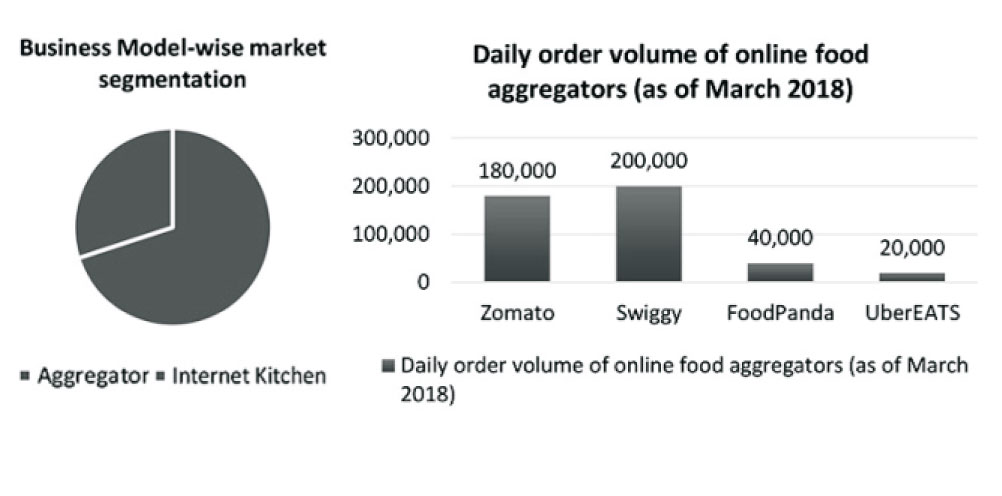
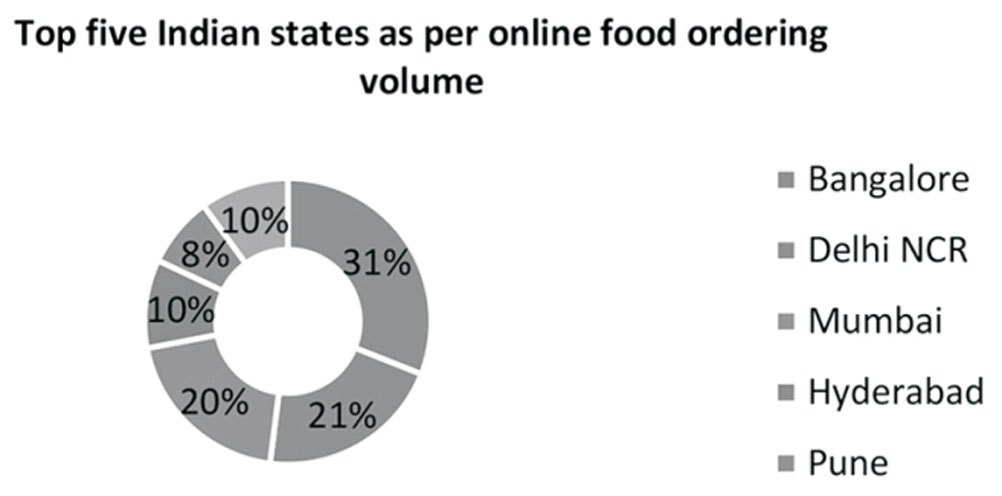
Demand Drivers
- Encouraging Demographics
- Promising Income and Consumption Levels
- Favorable Lifestyle Changes
- Rising Number of Working Women
Rationale of the study
The customer requirement in the restaurant business is changing. Eating in the restaurant is the need of the customer because of the fast life and scattered jobs. Going out to get the quality and variety of food after the tiring day is difficult for the customer. These changing needs is been satisfied by using online services. But to handle different customer requirement is the challenging job for the restaurants. These problems have been solved by food aggregators. India's online food-delivery market is currently pegged at $7 billion (Rs50, 375 crore). On the other hand, online fooddelivery platforms are expanding choice and convenience, allowing customers to order from a wide array of restaurants with a single tap of their mobile phone. Competition in the food aggregators is also increasing which certainly affects the business processes. Research has done on determinants of demand for online food services, choice among the aggregator services, impact of price, quality of services etc. But the impact demographic factors on the selection of online food services has not been considered. This paper identified the impact of demographic factors of consumer on willingness to order, frequency, awareness of terms & condition, knowledge about available restaurants, trust on payment mode.It has also identified the opinion of restaurants towards the certain factors like reach, profit etc.
Objective of the Study
- To identify the relationship between demographic factor and understanding of online market and behavior of consumer towards it.
- To provide information on the relationship of restaurants with online aggregators.
Literature Review
Ankur Kumar Rastogi (2010) explains that 44 percent
students use Internet in India and overall 72% of young
people access internet on regular basis. Factors
affecting ease of use, usefulness, and enjoyment along
with other factors like consumer individuality,
situational factors, product distinctiveness, previous
online shopping understanding and faith in online
shopping are influencing the online shopping
behavior. Online buying respondents feels that online
shopping has easy buying procedures, wide range of
products, low price and different payment modes. Dr.
Neha Parashar (January-June 2017), reveals that the
market size of food in India is expected to reach Rs. 42
lakh crore by 2020, investment in food startups, which
mainly include food ordering apps, has increased by 93
percent to $130.3 million. Foodpanda followed by
Swiggy and Zomato are the most preferred food apps
and respondents prefer cash on delivery. Mr. Mathews
Joao Chorneukar (2012- 2014), found that married
respondents were more satisfied with online food
ordering. Customer comes to know about online food
apps through friend. Most of the respondents even
today use telephone as the main source of
communication to use electronic food ordering. H.S.
Sethu, Bhavya Saini (july2016), the study reveals that
penetration of online food ordering services is high.
The millinions of these services are well versed with the
information available on these websites and also use
help services available online. The service providers
therefore forced to maintain quality of service levels.
The extrinsic factor like culture, socio economic,
reference group, and household and intrinsic factors
like experience, personality and self-image, and
perception and attitudes need are influencing on the
decision. Mustafa Abbas (September 2016) has explain
the models with few bottlenecks for food aggregator
services. These challenges are scalability, innovation,
cash required. Mrs I. Karthika, (2017), studies clearly
reveals the order of preference of online ordering food,
the first preference was given for the purchase of
ordering food through Swiggy. Dr. Sonali Jadhav
(April 2018) has explained the reasons of online market
growth is urbanization, increasing disposable income,
working women and rapid increase in the use of smart
phones & the adoption of technology by the restaurants
to caters changing need of the customer. Suryadev
Singh Rathore (December 2018) has explained the
changing trend of youth food habit, increases the
demand of online food. Dr.Vijaya Lakshmi
Kanteti(2018) explains that there are many popular
business models in the food tech and the top most
valued, unexplored and toughest model is the home
cooked food model. Technology provides significant
cost and efficiency improvements for restaurant
partners. The Indian Food tech start-up Industries is
taking the right opportunities to grow and achieve
profitability. Soham Trivedi (2018) explains that male
consumers are more preferred to buy online and the
Zomato is preferred over other aggregators. Suresh
Bhatt (2018) interpreted that social media is more use to
search information. He also mentioned 80% of brands
advertise on web, social and mobile, indicating that
more brands are spreading on digital advertising.
Methodology: Descriptive research was undertaken on
the basis of primary data collected from the two
respondents residing in Navi Mumbai region chosen
through non – probability convenience sampling using
a structured questionnaire.
The two set of respondents are:
1. Consumer using online food services
2. Restaurants owners who have collaborated with online food aggregator or looking to collaborate
Factor analysis is used with the sample of 521 used for
consumer survey and 100 restaurants for the study. The
collected data were analyzed using SPSS.
Analysis & Findings
Consumer behavior for online food aggregator
Behavior of consumer for online food aggregator has
been analyzed by using the demographic (Age , Marital
status, gender and occupation) and related behavioral
parameter that is willingness to order, frequency,
awareness of terms & condition, knowledge about
available restaurants, trust on payment mode.
H1: There is significant relationship between age and
willingness to order, frequency, awareness of terms &
condition, knowledge about available restaurants,
trust on payment mode.
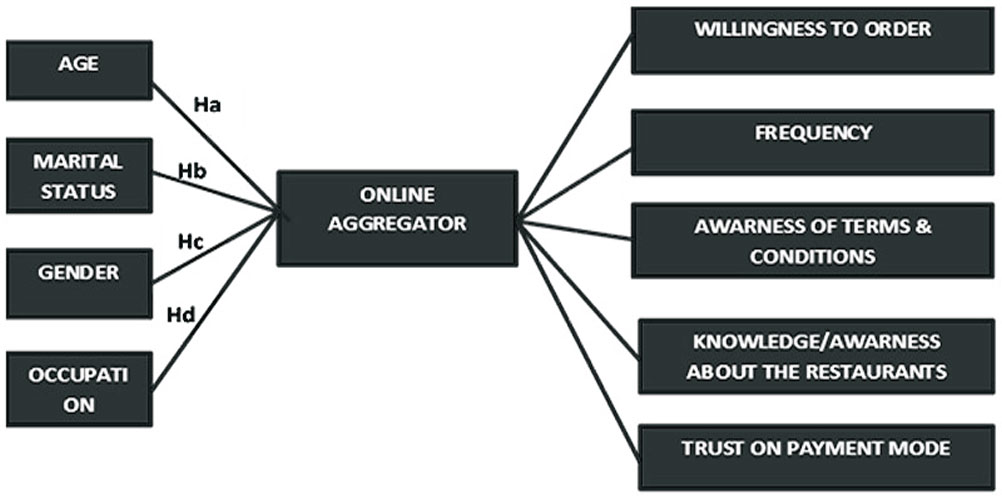
H2: There is significant relationship between marital
status and willingness to order, frequency, awareness of
terms & condition, knowledge about available
restaurants, trust on payment mode.
H3: There is significant relationship between Gender
and willingness to order, frequency, awareness of terms
& condition, knowledge about available restaurants,
trust on payment mode.
H4: There is significant relationship between
occupation and willingness to order, frequency,
awareness of terms & condition, knowledge about
available restaurants, trust on payment mode.
Demographic of Consumer


Factors for increasing Demand:
Consumers are ordering food from online aggregators
majorly because of the offers and discount available.
They have mentioned the mode of convenience and
availability of wide variety of product with in less time
are the reasons for using the services. The preferred
mode of payment by the online food users are cash on
delivery.

Co-relation between demographic factors & Parameters
Age: In fig.6 shows that all the chi-square value is more
than 0.05 hence we accept null hypothesis There is no
significant relationship between age the and
parameters that is willingness to order, frequency,
awareness of terms & condition, knowledge about
available restaurants, trust on payment mode.
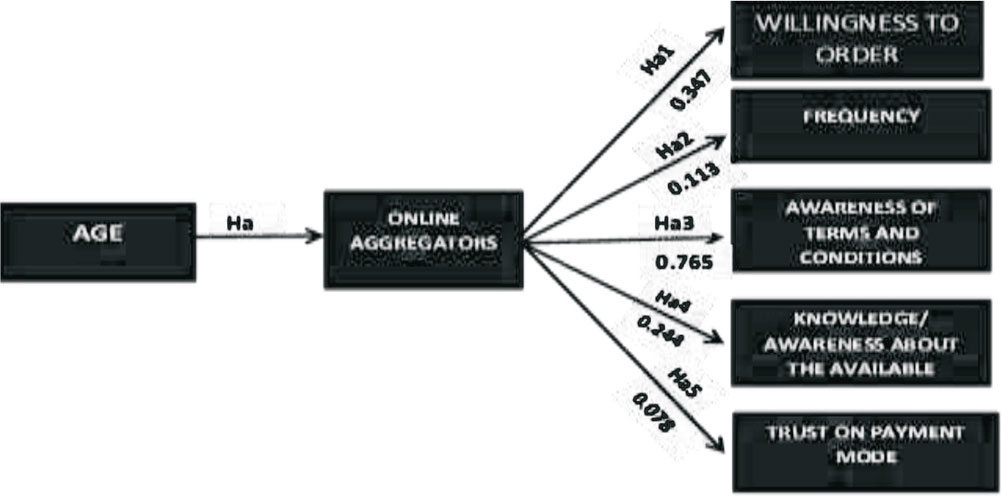
Fig.6 Correlation between age and online food services
Marital Status:
In fig.7 shows that all the chi-square value is more than
0.05 hence hypothesis is rejected. There is no significant
relationship between marital status and parameters
that is willingness to order, frequency, awareness of
terms & condition, knowledge about available
restaurants, trust on payment mode due to use of
services.
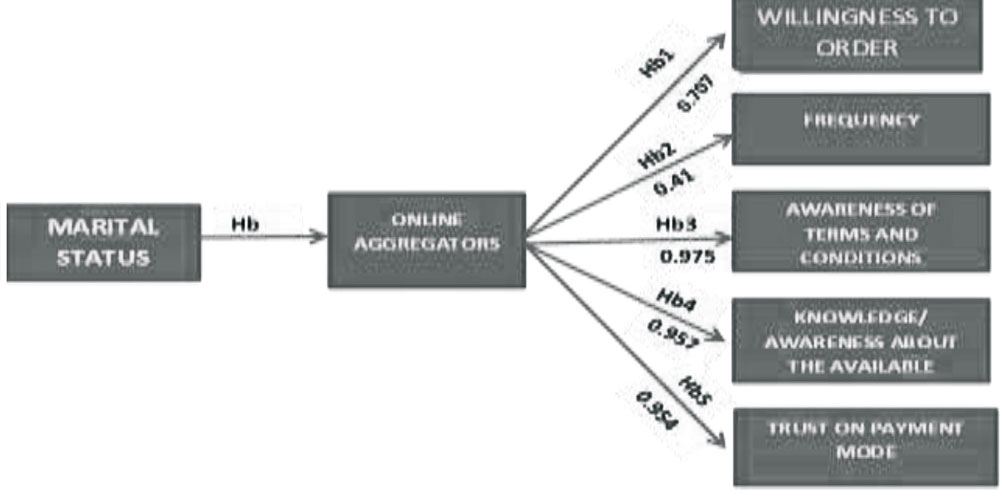
Fig.7 Correlation between marital status and demand of online food services
Gender :
In fig.8 shows that all the chi-square value is more than
0.05 hence we accept Null hypothesis. There is no
significant relationship between marital and
parameters that is willingness to order, frequency,
awareness of terms & condition, knowledge about
available restaurants, trust on payment mode.
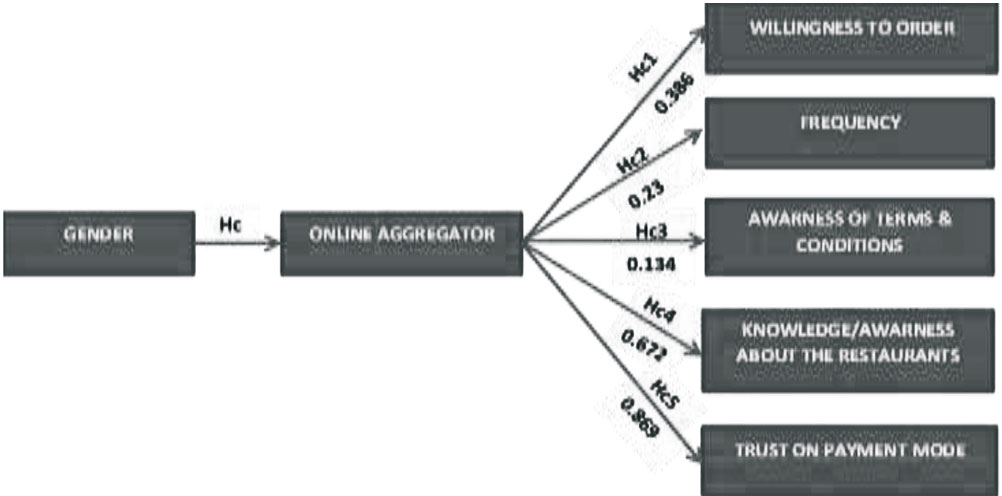
Occupation:
Occupation like service class people are high in term of
ordering food online than the business class.
In fig.9 shows that the chi-square value is greater than
0.05 that is there is no significant relationship between
the occupations like business, service, housewives,
students, professionals and willingness to order food
online, awareness of terms & condition, knowledge
about available restaurants, trust on payment mode.
We have also observed that there is significant
relationship between frequency of purchase and
occupation.
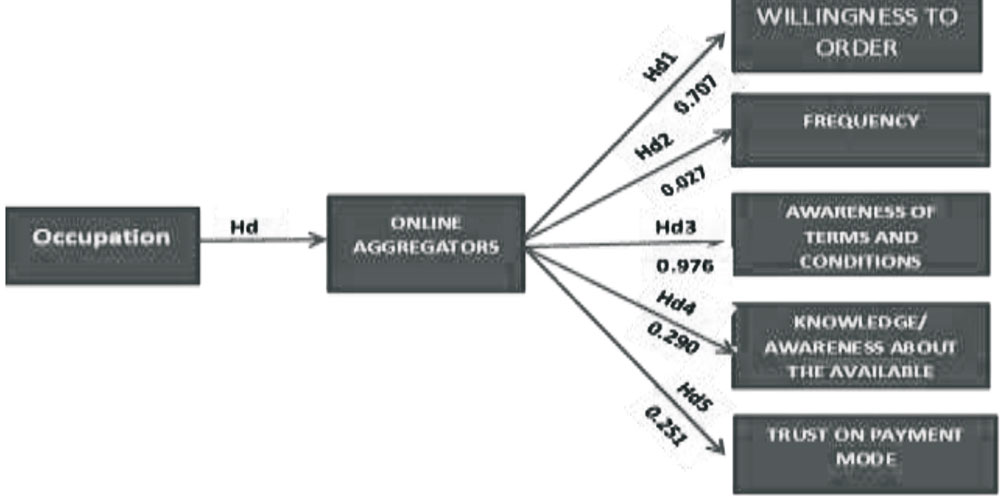
Fig.9. Correlation between Occupation and Demand of
online food services.
Analysis of Restaurants
The data of 50 restaurants has been collected and analyzed on 3 factors are(i) Customer feedback and visibility (ii) Profit and customer reach (iii) Satisfaction. From the above table, it is revealed that Benefit of customet reach is increase which is result of profit. It was found that the restaurants are facing lot of problem with the online aggregator. They are satisfied only for the feedback received and increase in reach of customer Increase in reach increase in profit and customer is satisfied for getting their services on time.
Conclusion:
Factors contributing to the popularity of online food
ordering among the millennials would be lack of time
to prepare food, availability of variety, affordable price
etc. There is a scope for improving the users'
satisfaction levels by understanding their expectations
more precisely and offering more attractive options
while ordering food online. Zomato is the major choice
of the respondents.
Rotated Component Matrixa
Generally, the online food order by the young
consumer, students who are living alone. Increasing
disposable income of family due to dual income and
less time to spend in family increases the relationship
between ordering online food. It has noticed that
generally people use online services either because they
have tired after the long office hours and avoid to go out
with family and demand of small kid to eat something
outside. Before marriage people prefer to go out with
friends.
It has also noticed that the food is generally ordered by
male in the family. Male is more because they are living
in group as a student or before marriage due to
affordability. They are working away from family.
During survey consumer also explain about the
problems on online food order regarding quality,
tampered food & Unhygienic food were delivered.
Most of the millennials wants the real image of the food
to be displayed on application. Customer care services
were not helpful most of the times.
In case of restaurants some restaurant wants to get
listed on Zomato and Swiggy but the request was
denied because of the size of the restaurant. The
commission charged from restaurants is relatively high
according to restaurants owner's and also complaint
about delivery boy's unprofessional behaviour.
Research Limitations/Implications : The study was
limited to a specified geographical area of Navi
Mumbai by considering the selected factors. The
restaurants data have issues of casual approach for
providing data and limited statistic available for food
aggregator .
Managerial Implications: As online food aggregator
business is growing and there is strong correlation
between demographics and the demand of online food
aggregators, the new business model must think on the
utilizing this information for making business models.
Behaviour of restaurant owners with online
aggregators are also limited to increase in reach of
customer and profit due to increase customer base also
need to change in strong collaboration.
Originality/Value : The paper offered fresh insights
into customers' expectations and the relative
importance of the factors considered by them while
ordering food online. The findings of this research can
be used by online food portals for bridging the gaps
between customer restaurant owners and to bring the
strategies which ensure sustainability of business.
References:
- Rastogi, Ankur. (2010). A Study of Indian Online Consumers & their Buying Behaviour. Research Analysis and Evaluation. 1. 80-82.
- Dr. Neha Parashar, Ms. Sakina Ghadiyali (2017), A study on customer's attitude and perception towards digital food app services, Amity Journal of Management January-June 2017.
- Mr. Mathews Joao Chorneukar ( 2012- 2014), To Study The Customer Perceptions Of Electronic Food Ordering, St. Joseph's Evening College – Pondicherry University Twinning Programme Pondicherry –605014,Batch (2012 – 2014) revealed from Http://Www.Sjput.In/Pdf/ Marketing%20sample%20project.Pdf.
- lSoham Trivedi (2018), Consumer Perception About Online Sales of Food in Indian Consumer Market, world Research Library http://www.world researchlibrary.org/ up_proc/pdf/1943-154098510427-29.pdf.
- H.S. Sethu, Bhavya Saini (july2016), Customer Perception and Satisfaction on Ordering Food , Proceedings of the Seventh Asia-Pacific Conference on Global Business, Economics, Finance and Social Sciences (AP16Malaysia Conference) ISBN: 978-1-943579-81-5 Kuala Lumpur, Malaysia. 15-17, July 2016. Paper ID: Kl631.
- Mrs I.Karthika, Miss. A.Manojanaranjani (2017), A Study on the various food ordering apps based on consumer preference, International Journal Peer Reviewed Journal R e f e r e e d J o u r n a l I n d e x e d J o u r n a l , http://www.wwjmrd.com/upload/a-study-on-thevarious- food-ordering-apps-based-on-consumerpreference_ 1544427485.pdf.
- Dr.Vijaya lakshmi Kanteti(2018), A study on online food delivery companies in India, IRJMST Vol 9 Issue 3 [Year 2018] ISSN 2250 – 1959 (online)2348–9367 (Print), http://www.irjmst.com/article_pdf? id=6578.pdf.
- Mustafa Abbas Bhotvawala, Harsh Balihallimath, Nishant B i d i c h a n d a n i , M . P . K h o n d N i s h a n t Bidichandani(September 2016), Growth of Food Tech: A Comparative Study of Aggregator Food Delivery Services i n I n d i a . h t t p : / / i e o m s o c i e t y . o r g / ieomdetroit/pdfs/49.pdf.
- Suryadev Singh Rathore ,Mahik Chaudhar (December 2018) Consumer's Perception on Online Food Ordering. Rennaisance School of Commerce and Management, MP, India Institute of Business Management and Research, MP, India. http://www.ijmbs.com/Vol8/ issue4/2-suryadevsingh- rathore.pdf.
- Dr. Sonali Jadhav (April 2018), Food Ordering Mobile Applications – A new wave in Food Entrepreneurship, AISSMS College of Hotel Management and Catering T e c h n o l o g y , P u n e , Ma h a r a s h t r a , I n d i a . ( h t t p s : / / w w w . i j l t e m a s . i n / DigitalLibrary/Vol.7Issue4/110-115.pdf). lhttps://www.statista.com/statistics/255146/number-of-internetusers- in-india/.
- ht tps ://www.we s r ch. com/bus ine s s/a r t i c l e s - details/articles-paper-BU187Q000IDAO-the-top-5-onlinefood-
- https://redseer.com/wp-content/uploads/ 2017/10/6.-
- Analyst-Report-Food-tech_CY16.pdf.
- https://blog.ifis.org/food-trends-in-india.
- https://orders2.me/the-4-most-common-problems-withonline- ordering/
